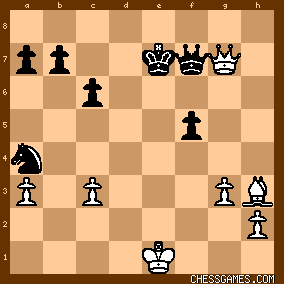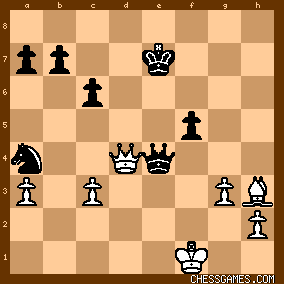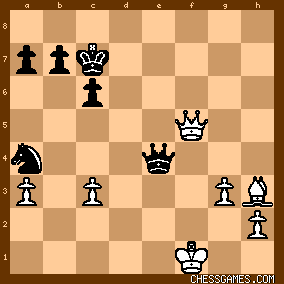KEG: Post IV
After 38. Kf1, von Popiel's counter-attack should have kept him in the game. But he made things needlessly difficult for himself (even before his losing blunder on move 45): 38... KxB
Better first to drive the King farther away with 38...Qb1+ 39. Kf2 Qc2+ 40. Kg1 and only then snatch the f6 Bishop. 39. Qh6+
39. Qd4+ was perhaps more accurate.
39... Ke7
40. Qg7+ Qf7
The position was now:

click for larger view41. Qd4
Pillsbury's best chance here seems to have been to swap Queens. This would have given him the better chances in the resulting endgame after 41. QxQ+ KxQ 42. Bxf5 Nxc3, but (unlike what occurred in the actual game) von Popiel's King would be adequately placed on the King-side to give him decent chances to hold the game. After the text, von Popiel should have been able to hold the game. 41... Qe6+
Again needlessly making things difficult for himself. 41...Nb6 would block any incursion by White's Queen on the Queen-side. 42. Kf1
Yet another inaccuracy by Pillsbury, whose mind seems to have been elsewhere until von Popiel's blunder on move 45. 42. Kf2 was plainly better. 42... Qe4!
Now, with Pillsbury's King on f1 instead of on f2 where he should have moved it, von Popiel would have an easy draw if Pillsbury had traded Queens. The position now was:

click for larger view43. Qg7+
Appearances notwithstanding, Pillsbury would have gotten nowhere after 43. Qxa7 (e.g., 43...Ke6 44. Qxb7 Qf3+ and Pillsbury's King can not avoid checks by the Black Queen wherever he runs. 43... Kd6
Although the text is fine, it suggests that von Popiel failed to realize that he needed to keep his King within range of the King-side in case Queens were traded. 43...Ke6 was therefore simpler (though the text would have been fine if properly followed up). 44. Qf6+ Kc7
Now von Popiel must run to the Queen-side, since 44...Kd5?? would lose the Queen to 45. Bg2. von Popiel was still fine--so long as he avoided trading Queens with his King so far from the King-side and White's dangerous pawns. 45. Qxf5
This left:

click for larger viewvon Popiel still had a draw in hand with 45...Qh1+ 46. Kf2 (forced since 46. Ke2 would allow 46...Nxc3+) Qxh2+. But--incredibly--von Popiel here played: 45... QxQ+ ??
Instead of an easy draw, von Popiel gets a clearly lost endgame: 46. BxQ Nxc3
The resulting position was:

click for larger viewAs I will discuss in my next post on this game, Pillsbury now has a clear win, albeit one that required patience and another 28 moves. | 




